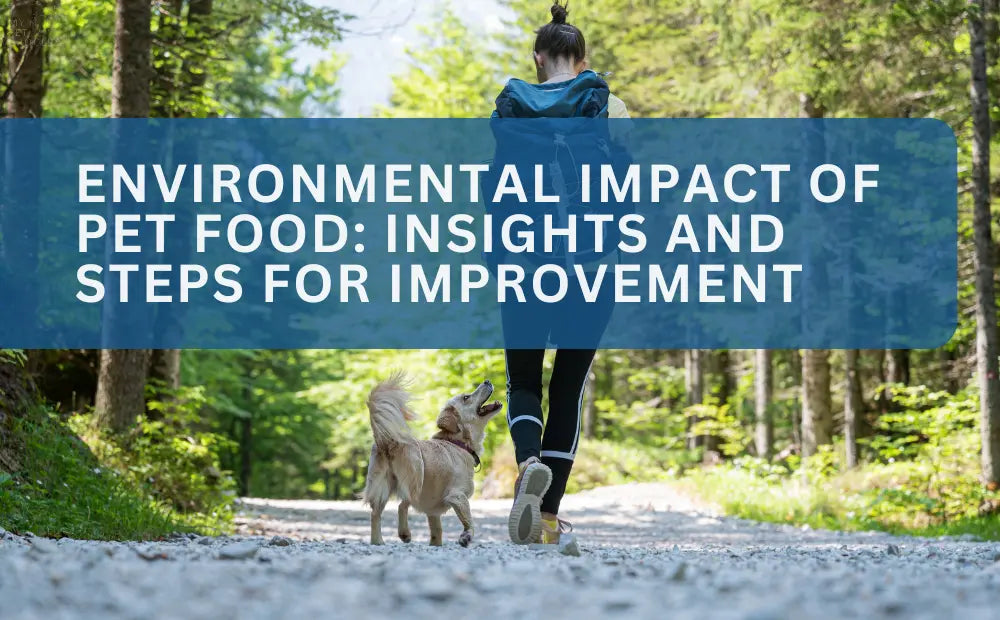
Environmental Impact of Pet Food
Pet food impacts the planet. From ingredient sourcing to packaging, every choice we make as pet guardians shapes our pets’ health and the environment’s future. This article explores the science, innovations, and everyday actions that can make pet food more sustainable without sacrificing nutrition.
By Danielle Conway, DVM, ACVIM-Eligible
More than ever, pet guardians like you are thinking beyond the bowl. As awareness grows about climate change, resource scarcity, and food system pressures, environmentally conscious pet guardians are starting to ask: How sustainable is my pet's food?
The truth is, pet food, especially traditional, high-meat formulas, has a measurable environmental footprint. From land and water use to greenhouse gas emissions and waste, what we feed our pets affects more than just their health. This article, drawn from both veterinary research and industry innovation, offers insights into how pet guardians and companies alike can reduce that footprint without compromising nutrition.
Why Sustainability in Pet Food Matters
Environmental sustainability is fast becoming a top consideration for many health-conscious consumers, and pet guardians are no exception. But as the pet food industry grows, it increasingly overlaps with the human food system, competing for the same resources. Premium pet food trends like grain-free, high-protein, or "human-grade" meals often require large quantities of meat, which can intensify environmental strain.
A fresh, biologically appropriate diet for dogs and cats can absolutely be part of a healthy lifestyle. The question is: how can we make that diet more sustainable? The answer lies in making informed, evidence-based choices about ingredients, sourcing, production methods, packaging, and education.
Pet food currently accounts for an estimated 25–30% of the environmental impact, from animal agriculture in the U.S. alone. This includes greenhouse gas emissions, land use, water consumption, and the energy required for food processing and transportation. In short, our pets' diets, while deeply important to their health, also carry real implications for the planet.
Learning from the Data: A Research-Driven Perspective
A 2018 study inspired by Dr. Kelly Swanson's landmark 2013 paper examined pet guardian knowledge and attitudes toward grain-free diets (GFDs) and environmental sustainability. The two-part survey measured understanding before and after participants read an educational brochure.
Key findings:
-
Before reading the brochure, only 44.9% could partially define a grain-free diet, and 19.2% were feeding one.
-
After reading, participants were significantly less likely to feed a grain-free diet (p < 0.001).
-
Initially, 47.4% could define environmental sustainability; that rose to 67.6% after reading.
Perhaps most importantly, the study revealed that while sustainability mattered to participants, decisions were still heavily influenced by health claims, marketing language, and personal beliefs.
This underscores a core insight: education, not fear, is what shifts behavior. When consumers are offered clear, evidence-based, and nonjudgmental guidance, they become more confident in making meaningful changes.
The Role of Veterinarians and Educators
Veterinarians play a pivotal role in helping pet guardians understand how their choices impact both health and sustainability. As trusted experts, they can:
-
Correct misinformation or misinterpretation about food trends (like the assumed superiority of grain-free or human-grade labels).
-
Explain digestibility and nutrient availability.
-
Recommend diets that align with both wellness and environmental goals.
Education campaigns can also play a role. Brands and vets can collaborate to create downloadable guides, social posts, and infographics that decode sustainability for pet guardians without overwhelming them.
When veterinarians proactively discuss these topics, pet guardians gain a more complete picture of what feeding responsibly looks like. It’s about balancing nutrition, convenience, ethics, and impact. That balance can only come from informed, compassionate conversations.
What Pet Food Companies Are Doing Right (And What to Look For)
Progressive pet food companies are taking meaningful steps toward sustainability, but identifying truly committed brands requires looking beyond marketing claims to examine actual practices and transparency.
1. Transparent Sourcing: Companies that clearly communicate their sustainable practices and ingredient sourcing build trust and accountability. Look for detailed information about supplier relationships, sourcing geography, and production methods. Companies committed to sustainability typically provide comprehensive sourcing information rather than vague sustainability claims.
2. Embrace Alternative Proteins: Insect protein, invasive fish species, plant-based proteins, and even lab-grown meat offer excellent nutritional profiles with dramatically lower environmental impacts than conventional meats. Insects, for instance, require a fraction of the water and land of beef and can be reared using food waste as feed.
3. Life Cycle Analysis: The most committed companies conduct and publish comprehensive environmental impact studies of their products. Life cycle analysis examines environmental impact from ingredient production through manufacturing, packaging, distribution, and disposal. Companies willing to share this data demonstrate a genuine commitment to understanding and reducing their environmental footprint.
4. Sustainable Packaging: Look for brands investing in recyclable, biodegradable, or reusable packaging options that actually protect the food properly. Sustainable packaging must balance environmental goals with food safety requirements. Some companies are pioneering innovative packaging solutions like compostable bags, reusable containers, and minimal packaging designs.
5. Supply Chain Control: Companies that maintain control over their supply chains and perform rigorous quality testing typically make more sustainable choices throughout their operations. Vertical integration or close supplier relationships enable better oversight of environmental practices, ingredient quality, and ethical standards.
6. Carbon Footprint Reduction: Progressive companies invest in practices that reduce overall carbon footprints through optimized supply chains, renewable energy usage, and water conservation during production. Some companies are achieving carbon neutrality or even carbon negativity through comprehensive sustainability programs.
7. Prioritize Digestibility: Highly digestible foods mean pets need less to get the same nutritional value. This leads to less waste, fewer emissions during production, and better health outcomes. Digestibility testing should be part of product development, not an afterthought. Digestibility also influences stool volume and quality, which matters both for pet comfort and for reducing the environmental burden of pet waste management in urban areas.
Ingredient Innovation: Smart Choices for Sustainability
Some of the most promising changes come from protein selection. Consider:
-
Poultry has a significantly lower environmental footprint than beef or lamb.
-
Eggs are sustainable, nutrient-dense, and highly bioavailable.
-
Invasive fish species help balance ecosystems while offering novel protein sources.
-
Insects like black soldier fly larvae require minimal land, water, and feed, and are highly nutritious.
However, as we said, digestibility matters. A novel ingredient is only sustainable if it meets nutritional needs and is well-absorbed. Companies exploring new proteins must invest in digestibility studies to ensure safety and efficacy.
There’s also the matter of nutrient balance. Some alternative proteins may be lacking in essential amino acids like taurine or methionine, particularly important for cats. That means these formulas must be properly supplemented, further reinforcing the importance of rigorous formulation, not trend-chasing.
Supporting Sustainability in Prey-Based Fresh Diets
Many pet guardians feeding fresh, prey-based diets may assume they can't also be environmentally conscious but that’s not the case. Here’s how they can align their feeding philosophy with sustainability:
1. Choose Ethically Sourced Meats
Opt for meats from regenerative agriculture systems or local farms that prioritize animal welfare and environmental stewardship. These operations work with nature, restoring soil health, supporting biodiversity, and reducing greenhouse gas emissions, making them a more sustainable option than conventional meat production.
2. Use Companion-Grade Ingredients
Incorporate nutrient-dense organ meats (like liver, heart, and kidney) and underutilized cuts that aren’t typically part of the human food supply. These “companion-grade” ingredients reduce food waste while delivering critical nutrients to pets that thrive on whole-prey nutrition.
3. Buy Seasonally and Locally
Selecting ingredients that are in season and grown or raised close to home reduces the carbon footprint tied to long-haul transportation and cold storage. It also supports regional food systems and small-scale producers who are often more invested in sustainable practices.
4. Embrace Whole-Animal Feeding
Feeding the whole animal—not just muscle meat but also bones, connective tissue, and organs—mirrors the natural prey model and maximizes the use of each animal. This reduces waste and respects the life taken to nourish your pet.
5. Incorporate Alternative Proteins
Consider rotating in alternative proteins like rabbit, duck, or even insect-based supplements (where appropriate and tolerated) to diversify the demand on traditional livestock systems. This can help lower the environmental strain associated with high-demand proteins like beef or chicken.
6. Trust Transparent Brands
Support pet food brands that publish detailed sourcing information, control their supply chains, and provide digestibility or bioavailability data. These companies are more likely to be accountable for both nutritional integrity and sustainability practices.
7. Use Eco-Friendly Storage
Reduce your plastic waste by storing pet food in reusable glass or stainless-steel containers. When freezing or portioning, compostable wraps or silicone pouches are a more sustainable alternative to single-use plastics.
8. Prepare Meals in Batches
Batch cooking or meal prepping reduces the overall energy used per meal and helps prevent spoilage or excess food waste. It’s also a time-saver, making fresh feeding more manageable for busy households.
Empowering Pet Guardians to Make Greener Choices
Individual pet guardians can have a meaningful impact. While no single action is a silver bullet, collectively, the shift toward sustainable feeding practices adds up. Here’s how:
-
Understand labels: Look for certifications (e.g., Marine Stewardship Council for fish, Global Animal Partnership for meat).
-
Measure portions: Overfeeding increases both waste and pet obesity.
-
Support eco-conscious brands: Your purchasing power drives industry change.
-
Minimize waste: Freeze leftovers, repurpose trimmings, and compost when possible.
-
Advocate for transparency: Ask brands about sourcing, packaging, and sustainability goals.
Moving Forward Together
Sustainability in pet food isn’t just a trend; it’s a necessity.
Pet guardians, veterinarians, and companies all have a role in reimagining how we nourish our animals in ways that support both their health and the planet’s well-being. By choosing nutrient-dense, ethically sourced, and highly digestible foods—and demanding greater transparency and accountability across the industry—we move closer to a future where pet health and environmental stewardship go hand in hand.
The future of pet food doesn’t require a trade-off between sustainability and nutrition. With innovation, integrity, and collaboration, we can craft diets that fuel long, vibrant lives without costing the earth; one bowl at a time.
